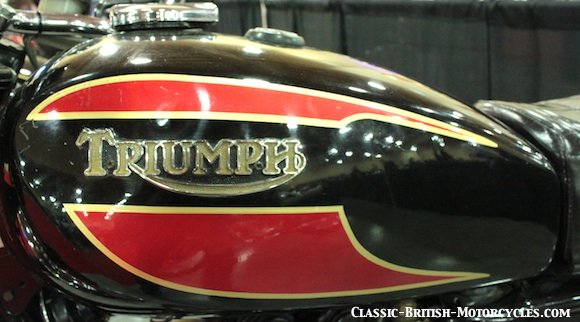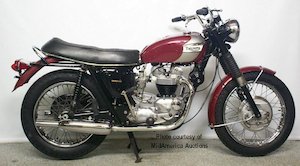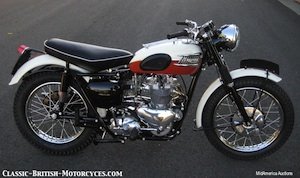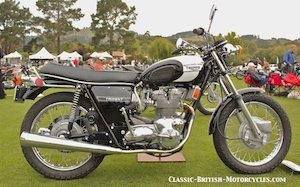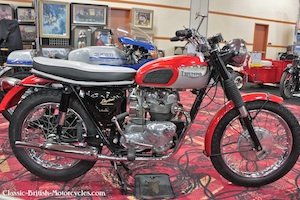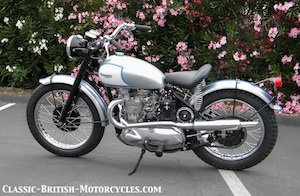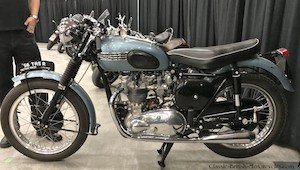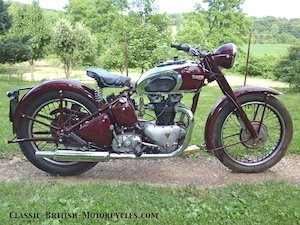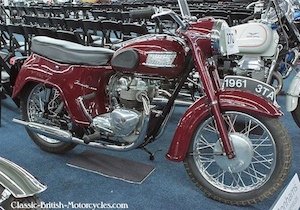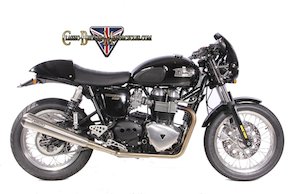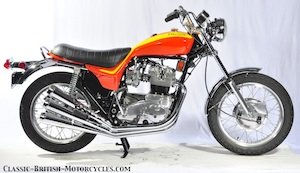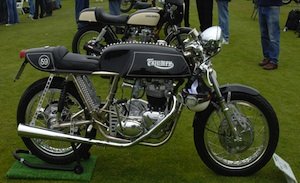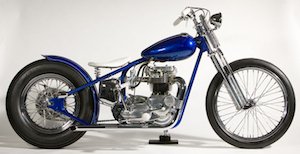TRIUMPH MOTORCYCLES WERE LEGENDARY
Triumphs are at the center of the Classic British Motorcycles universe. Names like the Triumph Bonneville, TR6, Trophy, Tiger, the radical 3-cylinder Trident, and the awesome TT Specials are just part of the story. One of the first motorcycle companies in England, and the last one to go belly-up in 1983, Triumph Motorcycles have always been (since World War 2, anyway) the best-selling, and most well-known, and some would say the best looking of all the Classic British Motorcycles.

ABOVE: The iconic Triumph Bonneville was their best-selling model, by far, during its 25-year lifespan (1959 through 1983).
ALWAYS THE COOLEST
Great performance, exceptional handling & stunning good looks have always been the hallmarks of classic Triumph Motorcycles. In the 1950s, before anyone had even heard of a Honda, if you wanted a fast bike, you bought a Triumph. Nothing else could touch them. Whether on the race track, blasting across the desert, or prowling the streets, Triumph Motorcycles defined high performance and had their own brand of ‘cool’. So cool in fact, that Marlon Brando rode a black Triumph 6T Thunderbird in the classic biker movie “The Wild Ones”, not a Harley, as one might expect.

ABOVE: This 1952 Thunderbird pays tribute to Brando’s ‘Blackbird’, but this one’s not…black.
SPEED TWIN ROCKS
Triumph literally rocked the motorcycle world in 1937 with the introduction of the 500 Speed Twin, a radical departure from the status quo at the time. Most bikes were single cylinder designs, other than a few big V-twins and 4-cylinders. Singles were hard to start and vibrated badly, and they had reached their practical limit at around 500 cc. The Speed Twin took engine design in a whole new direction. It was the brainchild of designer Edward Turner (who also designed the Ariel Square Four).
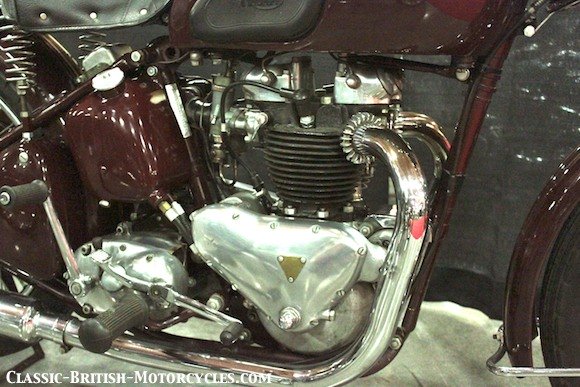
ABOVE: This 1947 Triumph Speed Twin established the standard Brit layout for decades to come: 2 vertical cylinders, both pistons moving up and down together (360-degree crank), 2 main bearings, pushrods and rockers working the valves, all in a very compact package.
THE MAGIC FORMULA: THE PARALLEL TWIN
Rather than making the cylinder bigger, he split it into two smaller cylinders. By making them parallel, they kept the weight and engine width down to about the same as the singles, allowing Turner to shoehorn the new engine into an existing single frame. It was an instant hit, and set the standard for nearly every British twin cylinder motorcycle built for the next 45 years! Even the mighty Soichiro Honda liked the basic layout so much that he copied it many times.
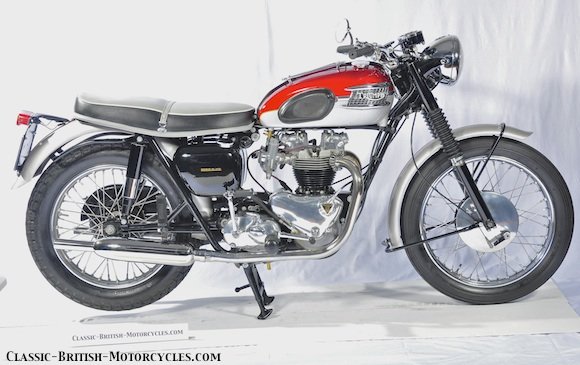
ABOVE: This 1962 Bonneville is a classic example of a PRE-UNIT TWIN, and is the last year for Pre-Units.
TRIUMPH’S HEYDAY
The Triumph Speed Twin had just been launched in 1938 when war broke out & all civilian production was curtailed. Triumph Motorcycles began building side valve motorcycles for the British Army. But, as soon as the war ended, despite severe rationing of everything from steel, to rubber to electricity, Triumph resumed production, but only twins would be built. The 5T Speed Twin (500) was reintroduced in 1946, followed soon after by the hotter T100 Tiger (a 500). Soon, this was not enough, so the 500 was bored & stroked out (another Turner idea) to 649cc and the 6T Thunderbird was born, ushering in an era of 650 dominance, on the streets and in the showroom. But there was more to come. A hotter version of the 650 twin, the T110 Tiger would follow the T-bird in 1953, only to be eclipsed by an even hotter version in 1956, the legendary TR6. Of course, the pinnacle of twin performance, the twin-carb Bonneville made its debut in 1959. All during the 1950’s & through the 1960’s, Triumph Motorcycles were preeminent among high performance bikes & enjoyed roaring success in the showrooms.

ABOVE: This 1965 Bonneville is the archetype UNIT-CONSTRUCTION TWIN, which replaced Pre-Unit Construction in 1963 for 650s.
UNBEATABLE ON THE STREET, DEFEATED IN THE BOARDROOM
Triumph, as it turned out, was one of the few British Motorcycle Companies that was actually doing well. AMC (with Matchless, AJS and Norton) failed and was gobbled up by Manganese Bronze Holdings. BSA, parent company to Triumph Motorcycles, once THE largest producer of motorcycles, and one of the largest multinational corporations in the world with vast holdings including many other motorcycle companies, had thrived throughout the 1950s, but began floundering in the 1960’s. Triumph and Norton seemed like the only two players that could survive. But would they?
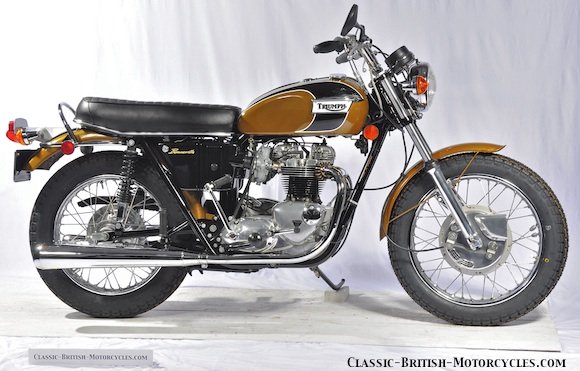
ABOVE: This 1971 Bonneville was the first year for the next generation of Triumphs, the OIL-IN-FRAME bikes which ran from 1971 through 1983, when the Meriden Co-op finally stopped making them.
LONG IN THE TOOTH
Unfortunately, even the most brilliant design of 1937 must ultimately be cast aside as newer, more sophisticated designs come along. Even the ultimate development of Triumph Motorcycles vertical twin, the Triumph Bonneville, and the radical Triumph Trident 750 triple weren’t enough to stem the tide of progress. As better, faster, cheaper motorcycles began pouring into the marketplace from Honda, Kawasaki, Yamaha and Suzuki, Triumphs just weren’t relevant anymore as high performance motorcycles. 1960’s performance couldn’t hold a candle to 1970’s performance and it just wasn’t possible to pump much more out of the venerable old 650/750 twin. Even the mighty Trident wasn’t enough to counter Honda 750/Fours and Kawasaki Z-1s. All that, plus bad management and labor problems spelled the end to the old classic Triumph motorcycle company in 1983. By this time the entire British Motorcycle industry had failed, Triumph had been the last one standing. The good news is that Triumph is back in business and building wonderful new, modern motorcycles in England. They’re even building a new Triumph Bonneville. BULLY!

ABOVE: The Trident was a bold move by any standard. The radical 3-cylinder was fast and handled well. But it was expensive and was eclipsed by the game-changing Honda 750-Four.
THE END DRAWS NEAR
The story of the rise and fall of the British motorcycle industry is an amazing story. The rise is typical enough, but the fall is nothing less than flabbergasting! How does a company like BSA, the world’s largest producer of motorcycles and one of the largest multinational corporations in the world at the end of the 1950s, decline so rapidly and completely during the 1960s, and completely fail by 1972? At that time, BSA owned BSA, Triumph, Norton, Matchless-AJS, Ariel, Sunbeam, Francis-Barnett, Villiers and James. Despite all that industrial might, they still couldn’t get it together. Perhaps the prevalence of so many competing brands was part of the problem, and of course antiquated design and manufacturing hurt them dearly, once the Japanese arrived. But the biggest problem with the BSA Empire by far was mismanagement, on an epic scale. It’s more than can be adequately explained here. Perhaps a future page dedicated to this subject would be in order. However, if you really are interested in the final days of the Classic British Motorcycle industry, and Triumph in particular, I highly recommend the book:
SAVE THE BONNEVILLE!
Save the Triumph Bonneville!: The inside story of the Meriden Workers’ Co-op
It was written by John Rosamond, who started out as a welder in the Meriden factory, building new oil-bearing frames in 1971. He climbed the ladder just as Triumph began to teeter, went through the year-long strike and factory closure, then reemerged as Chairman of the new worker-owned Meriden Co-Op. This is an incredible story as seen from the inside, with details that can’t be found anywhere else. I highly recommend all diehard Triumph fans read it.

ABOVE: This is a 1982 Triumph Bonneville TSS. It employed a completely different (and all-aluminum) top end including a 4-valve-per-cylinder head. Just 438 were built.
THE FINAL GASP
Running out of money and time, with few resources at their disposal, the scrappy Meriden bunch engineered a hot new version of the ancient Bonneville called the T40W TSS. Based on the Westlake Engineering 8-valve cylinder head, it used an all-new one-piece forged steel crank, 10:1 compression and two 34mm Amal MkIIs to produce 58 horsepower at 6500 rpm. Quite an accomplishment in itself, considering the standard Bonneville made 49 hp. But, due largely to the new one-piece crankshaft, the TSS was very smooth and vibration-free, compared to its contemporaries. And it had an electric starter! Slick mag wheels, dual disk brakes, high-quality European cycle gear and a sexy paint job weren’t enough to stem the tides of insolvency. These bikes, as advanced as they seemed when compared to any other British bike of the era, were still largely hand-built by artisans in an antiquated factory with the most rudimentary of tooling, all based on an ancient, hopeless outclassed design. After endless struggles and sacrifices, the Meriden Co-Op finally gave up the ghost in 1983. The Meriden factory, hallowed ground in motorcycledom, closed it’s doors, the Co-Op slipped into receivership and the creditors came swooping in to snatch up what little was left. A tragic end to a much-storied brand…
But wait, the story doesn’t end there…

ABOVE: This 2004 Triumph Bonneville shows how hard the new Triumph tried to remain faithful to the classic. And they came out fantastic! Imagine, the looks of a classic Brit bike without all the reliability problems. Congratulations, lads!
A NEW LEASE ON LIFE
When the Meriden operation was winding up, a mega-successful British real estate developer named John Bloor quietly acquired all the company’s assets, parts, tooling, drawings, the name, and all the rights. His original plan was to work through the old design and come up with a modern version of the old bike. This proved to be impractical, so he started with a clean sheet in the mid-1980s, and by 1991 they were ready to release their first new bikes, which included two ranges of triples, 750 and 900 respectively, and the new 800 Bonneville. While staying true to the looks of the classic Bonneville, all the latest hardware was included: 4 valves-per-cylinder, dual overhead cams, fuel injection, and, thanks to modern CAD/CAM, a level of precision and quality that the old Meridan factory could never have approached. The new Triumph factory is located in Hinkley, England, and so all new Triumphs are referred to as Hinkley Triumphs, and all classic Triumphs are referred to as Meridan Triumphs. Much to their credit, they have revived the love and appreciation of British bikes in the modern day.
HISTORY OF TRIUMPH PRODUCTION 1937-83
1937-40……….Tiger 70 (249cc OHV single)
1937-40……….Tiger 80 (349cc OHV single)
1937-40……….Tiger 90 (497cc OHV single)
1937-40……….5T Speed Twin (498cc OHV twin)
1938-40……….Tiger 100 (498cc OHV twin)
1940-45……….World War 2 halts civilian production
1946-58……….5T Speed Twin (498cc OHV twin)
1946-59……….Tiger 100 (498cc OHV twin)
1949-58……….TR5 Trophy (498cc OHV twin)
1950-66……….6T Thunderbird (649cc OHV twin)
1954-61……….T110 Tiger (649cc OHV twin)
1954-68……….Tiger Cub (200cc OHV single)
1956-70……….TR6R/C Trophy (649cc OHV twin)
1957-66……….3TA/Twenty One (348cc OHV twin)
1957-66……….5TA (490cc OHV twin)
1959……………T100 Tiger (490cc OHV twin)
1959……………T120 Bonneville (649cc OHV twin, 2 carbs)
1960……………TR7A/B Bonneville (649cc OHV twin, 2 carbs)
1961-72……….T120C/R Bonneville (649cc OHV twin, 2 carbs)
1960-61……….T100A Tiger (490cc OHV twin)
1962-65……….T100SS Tiger (490cc OHV twin)
1963-69……….T90 Tiger (348cc OHV twin)
1966-67……….TT Special (649cc OHV, 2 carbs, racer)
1966-74……….T100R Daytona (490cc OHV twin, 2 carbs)
1969-74……….T150/V Trident (740cc OHV triple)
1970……………T120RT Bonneville (750cc OHV twin, US only)
1971-72……….T120RV Bonneville (649cc OHV twin, 5 speed)
1971-72……….TR6R/RV Tiger (649cc OHV twin)
1973-83……….TR7RV Tiger 750 (744cc OHV twin, 5 speed)
1973-83……….T140RV/E Bonneville (744cc OHV twin, 5 speed)
1973……………X75 Hurricane (740cc OHV triple)
1975……………T160 Trident (740cc OHV triple, elec start)
1977……………T140J Bonneville Jubilee (744cc OHV twin)
1979……………T140D Bonneville Special (744cc OHV twin)
1981……………T140LE Bonneville Royal Wedding (744cc twin)
1982……………T140 TSX factory custom (744cc OHV twin)
1982……………T140 TSS (744cc 8-valve twin)
CONVERSIONS TO UNIT CONSTRUCTION:
350 twin………First year of Unit Construction: 1957
500 twin………First year of Unit Construction: 1959
650 twin………First year of Unit Construction: 1963
Triumph Motorcycles MODEL-BY-MODEL
BONNEVILLE, 1959-1983
T120 & T140 – 650 & 750 twins
Triumph’s hotrod twin had dual carbs, more power & better handling than just about anything else on the market at the time.
TR6 (650), 1956-1972
TR6 – 650cc twin
TR7, 1973-1983
TR7 – 750cc twin
Triumph’s single-carb 650 was the hottest thing going until the Bonneville arrived. It still remained competitive, on the street, the track and in the desert.
TRIDENT, 1969-1975
T150 & T160 – 750cc triple
Triumph launched its radical 3-cylinder 750 just weeks before Honda released its game-changing 750 Four.
T100R DAYTONA, 1967-1974
500cc twin
TROPHY
TR5 & TR6 – 500 & 650cc twins
TIGER
T100 & T110 – 500 & 650cc twins
TRIUMPH TR5
Triumph’s 500 twin came in many forms. This one is a 1956 TR5R Roadster.
THUNDERBIRD, 1949-1966
6T – 650cc Twin
SPEED TWIN, 1938-1966
5T – 500cc twin
The bike that started it all, not just for Triumph, but for the entire British motorcycle industry. Edward Turners seminal design launched a new class of motorcycle.
From 1946 through 1966, Triumph built sweet 350 twins based on the 500, so they were robust. Intended as their low-cost, economy commuter, Triumph’s 350 twins were known for their peppy performance.
TIGER CUB
250 Single, 1954-1968
Triumph’s entry-level 250 single was the bike that many a young Brit learned to ride on.
Triumph was reborn in 1990 as a modern motorcycle brand. The retro Bonneville launched in 2000.
X-75 HURRICANE, 1973
X75 – 750cc triple
Triumph’s awesome factory custom actually started out as a BSA, but BSA went broke before it could be introduced. Designed by fairing guru Craig Vetter, they are among the most beautiful production motorcycles ever built (my opinion).
Cafe Racers seem to be built around Triumphs, or Triumph engines more than any other British brand. Makes sense, there are more Triumphs than the other Brits. Check out what some owners & some shops have been building…
Choppers & bobbers of every kind, new- and old-school, are being built around Triumph motorcycles and Triumph engines. Check out some of the magic…
Check out these TRIUMPH BOOKS
Vintage Motorcycle Calendar – Classic Motorcycle Calendar – Calendars 2018 – 2019 Wall Calendars – Motorcycle Calendar – Classic British Motorbikes 16 Month Wall Calendar by Avonside
Triumph Motorcycles: The art of the motorcycle
The Complete Book of Classic and Modern Triumph Motorcycles 1937-Today (Complete Book Series)
Triumph Motorcycles: From Speed-Twin to Bonneville
Triumph Bonneville and TR6 Motorcycle Restoration Guide: 1956-83
British Motorcycles Triumph (Little Books)
Triumph Motorcycles in America
McQueen’s Motorcycles: Racing and Riding with the King of Cool
Triumph Motorcycle Restoration
Illustrated Triumph Motorcycles Buyer’s Guide: From 1945 Through the Latest Models (Illustrated Buyer’s Guide)
Tales of Triumph Motorcycles and the Meriden Factory
Hinckley Triumphs: The First Generation (Crowood Motoclassic)
For more like these, visit our
TRIUMPH BOOK STORE
 |
PLEASE BUY MY NEW E-BOOK HERE 12 Chapters & over 100 original photos. My best work yet. ONLY $4.99! Thank you, Andy Tallone, your humble authorClick here to buy now: The Random History of Classic British Motorcycles, Volume 1 |


